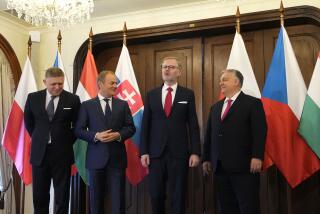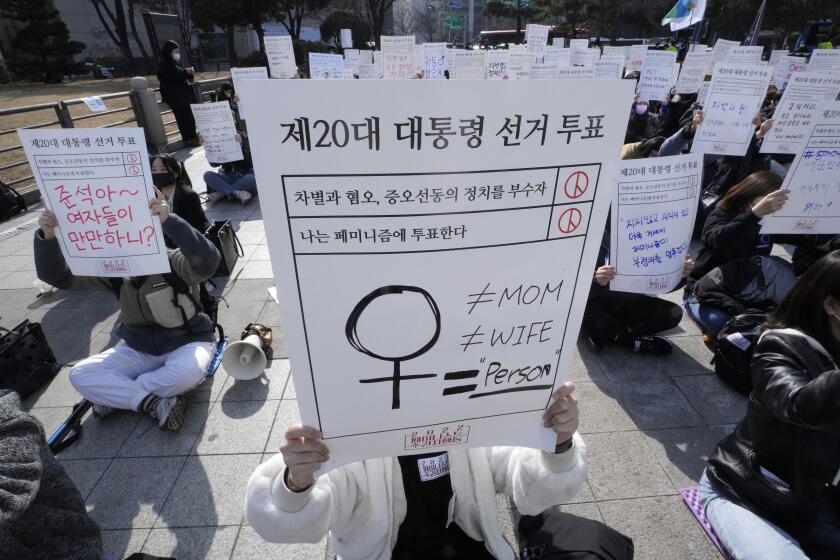The ‘Powder Keg’ Revisited : Eastern Europe: An analogy with Austria-Hungary in 1914 is ominous. If the West wants to avoid a repetition of those events, it must work very hard on better outcomes.
- Share via
It is surely one of the greatest ironies of modern history that we are going to enter the final decade of the 20th Century just as we entered the first--deeply concerned that the tensions and rivalries within Eastern Europe will lead to widespread political instability and, in turn, to a crisis in the international system.
For all the sweeping global transformations that have occurred over the past 80 years (the end of the colonial empires, the Cold War, the rise of the Pacific Rim), statesmen and strategists still have to keep a watchful eye on what is happening to that swath of peoples and territories lying between the western borders of the Soviet Union and the eastern borders of Germany. Whether we like it or not, we cannot escape the memories of 1914 and, to a lesser degree, of 1939.
There were two reasons why Eastern Europe was viewed as a “powder keg” at the beginning of this century. The first was that one of the traditional great powers in the region--the multinational Austro-Hungarian Empire--was showing visible signs of internal fissuring and impending collapse. And while the Empire of the Hapsburgs was not loved by the many peoples (Czechs, Poles, Serbs, Italians) under its jurisdiction, its existence had at least guaranteed territorial stability so long as it lasted. This was the more worrying because of the second reason--namely, there existed a whole cluster of local and territorial rivalries (e.g., Czechs versus Germans, Hungarians versus Romanians) that were only partially suppressed by Hapsburg rule and would most likely break out again if that rule were withdrawn. What new structures and agreements could replace that stability if the Austro-Hungarian Empire disappeared or was greatly reduced in size? What would happen if czarist Russia or imperial Germany moved into the power vacuum created by the demise of the Austro-Hungarian Empire? More immediately, what would happen if arch-conservative and military circles in Vienna reacted to the internal fissuring by forcibly suppressing all movements for political freedom?
It is with exactly those same questions that we have to concern ourselves today. This time it is the multinational Soviet Empire that appears to be threatened by internal unrest and disintegration. From the Baltic states to the Muslim republics in the south, the centrifugal forces are all too evident. In addition, economic distress and political discontents have led to tremendous pressures for change within every one of the Soviet Union’s satellite states in East-Central Europe, with the Poles and the Hungarians now boldly proceeding with far-reaching liberalization measures, the East Germans on the brink of their own changes following the departure of Erich Honecker, while the Czech and Bulgarian authorities strive in vain to preserve the old Marxist order and fierce internal suppression continues unchecked in Romania.
Moreover, just as at the beginning of the century, age-old linguistic and ethnic disputes threaten once again to break to the surface: Romanian and Bulgarian policies against minorities enrage the Hungarians and the Turks respectively; in the south, Yugoslavia quarrels with Albania even as its own federated system disintegrates. Most of these disputes (the Yugoslav question excepted) have hitherto been checked by the Soviet imperium, the presence of Red Army divisions and the structure of Warsaw Pact integration. If the latter disappears, may we not witness a whole series of open territorial disputes?
As if this all were not enough, there now looms the complicating factor of the revival of the “German question”--that is to say, the possibility that much of this region could come under the growing influence of Europe’s economic powerhouse, Germany, as was the case in the 1930s. As many commentators have pointed out, the Cold War division of Europe may have provided only a temporary “solution” to the German question by cutting Germany in two and “anchoring” each part within the two alliance blocs led by its respective superpower. But what if the Soviet Bloc is indeed going to disintegrate? What will happen to the German Democratic Republic if its Marxist ideology and political economy--the only real justification for its existence as a separate state--is thrown overboard in a wave of liberal reforms? Are we ready for the return of a reunited Germany of more than 80 million people, whose industrial efficiency and financial resources would make it a natural magnet for most of the desperate peoples and governments of Eastern Europe? Are the West Germans themselves--not to mention their Western allies--ready for this?
The largest question still remains: What will the Soviet leadership do? Will it tolerate the further decentralization of the Soviet Union itself, the “drifting westward” of Poland and Hungary, the metamorphosis of the German Democratic Republic into a de facto attachment to the Federal Republic, the steady withdrawal of Soviet troops and influence across Eastern Europe? Or will conservative forces in the Kremlin and Red Army, alarmed at the instability and loss of control, insist upon a forcible suppression of all these liberalization tendencies and manifest a deep hostility toward another great power whose influence appears to be rising as its own is swiftly sinking? It is here that the analogy with Austria-Hungary in 1914 is the most ominous.
If the West wants to avoid a repetition of those earlier disastrous events, it ought to be working very hard now to try to avoid them. At the minimum, there ought to be a vastly enhanced package of aid and development measures for Eastern Europe, and very serious consideration of the options--and the hazards--by the leading European Community countries and the United States. In addition, the announcement of the forthcoming summit between President Bush and Soviet President Mikhail S. Gorbachev offers the United States the chance of a frank exchange of fears and hopes with the Soviet leader about the future of Eastern Europe. This is not the time, and that area of the world, is not the place where we should be simply waiting and watching to see what will happen.
More to Read
Sign up for Essential California
The most important California stories and recommendations in your inbox every morning.
You may occasionally receive promotional content from the Los Angeles Times.













